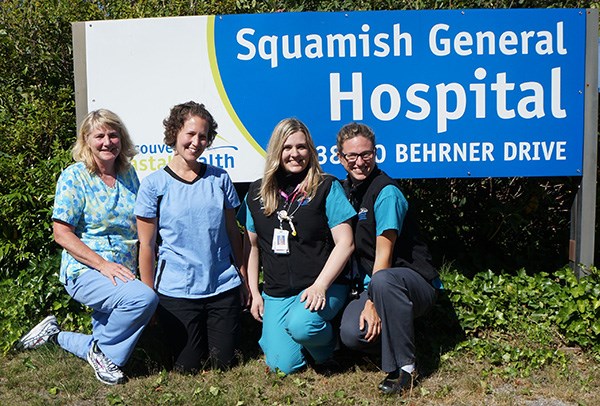Thor Froslev, the beloved unofficial mayor of Brackendale, has had more than his share of trips to the hospital of late.
Recently, he had a pacemaker put in, and while no one likes being sick or going to the hospital, Froslev said he doesn’t mind going to Squamish General.
“When you go to the hospital in Vancouver, and they drive you back to Squamish hospital, it is such a relief that you are home,” said Froslev. “You know all the patients, all the visitors and all the nurses and staff. It is great that you can be in the neighbourhood like that.”
Squamish General Hospital, built in the 1980s, has 21 beds and provides general medicine, surgery, obstetrics, palliative care, physiotherapy, chemotherapy, and emergency care.
Some people assume big city hospitals are better for patients because they have specialists and the latest technology, and some statistics back up that assertion. Teaching and large hospitals scored in the top 10 of the 15 Canadian hospitals with the lowest readmittance rate over the past three years, according to Canadian Institute for Health Information (CIHI) data. Only two small community hospitals cracked the top 15, and Squamish wasn’t one of them. (Quebec did not participate.)
But Squamish’s hospital has some numbers of its own to flaunt.
When it comes to the sick being readmitted to hospital, Squamish was at 8.2 per cent readmittance for 2013-2014, below the Canadian community hospital average of 9.5 and well below the Vancouver Coastal Health average of 10.2 per cent. Readmittance rates are important because they represent urgent returns to hospital, which are costly for hospitals and traumatic for patients, according to the report.
Hospital stays last an average of 4.4 days at Squamish General, according to CIHI.
For nursing manager Cindy Sellers, patient services coordinator Nancy Haffey, nurse educator Veronica Fincham and the many nurses who work 12-hour shifts, Squamish Hospital is where they see their neighbours.
“Usually patients take comfort in recognizing their nurse or being able to have their family doctor look after them in hospital,” said nurse Marcia Kent.
In 2014 the nursing program Releasing Time to Care, which aimed to improve the care delivered to patients by allowing nurses to propose solutions for their patients, won a Vancouver Coastal Health Quality award.
Kent said one of the biggest challenges nurses face is having to transfer patients out of the hospital due to a lack of resources.
“For example, diagnostic tests such as a CT scan [computerized tomography]
or specialists. The patients have to go on a road trip to Lions Gate Hospital,” she said.
Transferring is harder on the patients and uses valuable resources.
“We have to utilize our ambulance services to transport patients for diagnostic tests, often with a nurse escort,” Kent said.
The lack of a CT scanner is something that challenges Dr. Richard Cudmore, who has worked at Squamish General since 1978.
“We really are underfunded for our diagnostic imaging. We are the only hospital in Vancouver Coastal that doesn’t have a CT scanner, which is a huge deficit,” he said.
Cudmore said the Squamish Hospital Foundation has stepped up to help by raising funds for some equipment, including a recently purchased piece of anesthetic equipment.
The hospital also doesn’t have mental health beds.
Overall, though, Cudmore said the hospital provides its patients with customized, excellent care.
He said the hospital has paid attention to the uniquely young demographic of the community it serves, which includes in its catchment the corridor up to Lillooet.
The median age in Squamish is about 37.
“We have developed a robust obstetrics program. We are the only hospital in the province that has midwifery services without specialists’ back up; we have a group of general practitioners with a special interest in obstetrics who will back the midwives up,” he said.
Cudmore said the hospital’s orthopedic program reflects the outdoor pursuits popular in the corridor with two advanced orthopedic surgeons with fellowships and specialties in upper and lower extremity injuries.
“People get torn shoulders and torn knees, and that is what we specialize in.”
Cudmore said one of the biggest problems with city hospitals is how long people have to wait for elective procedures, and that patients can often be bumped if more severe cases arise.
“We, generally speaking, do well with our elective procedures – we don’t have to send people home very often,” he said.
The hospital has a newly renovated emergency department and wait times are dramatically shorter in Squamish than in a city hospital, Cudmore said.
Cudmore said Lions Gate and Vancouver General hospitals battle to get their wait times to around 10 hours, whereas in Squamish sometimes patients don’t wait at all in emergency. The growing population in Squamish has meant the department is busier than it used to be, but it is manageable, he said.
For patients such as Froslev, the hospital’s facts and figures don’t matter so much.
“As you get wheeled into your room, it just really feels comfortable, as a hospital goes,” Froslev said.



